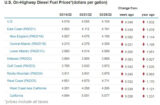NEW YORK — Oil prices soared Tuesday, driving gasoline and diesel prices even higher as Russia stepped up its war on Ukraine.
The national average price of diesel rose 4.9 cents to $4.104 a gallon in its latest increase, according to Energy Information Administration (EIA) data released on Monday. Diesel costs $1.032 more per gallon than it did at this time in 2021.
The price of a gallon of diesel increased in all 10 regions in EIA’s weekly survey, with the largest being 8.2 cents in New England. Gasoline took a bigger leap, climbing 7.8 cents nationally to reach $3.608 a gallon.
The price hike is eating into the bottom lines for many truckers, especially independent owner-operators.
Rick Sanders, who has just one rig operating out of Nebraska, said he isn’t sure how much longer he will be able to eat the cost of rising fuel prices.
“It’s like they don’t care about the little man,” Sanders said. “You see all this aid and stuff going to other places, but who is doing something to help us? When is someone going to give us a break? We pay our taxes, we do what we are supposed to do, but there always seems to be something holding us back from making our share of the pie.”
To help ease some of the pain, the International Energy Agency’s 31 member countries agreed Tuesday to release 60 million barrels of oil from their strategic reserves — half of that from the United States — “to send a strong message to oil markets” that supplies won’t fall short after the Russian invasion of Ukraine.
Meanwhile, stocks fell as investors tried to measure how the conflict will impact the global economy. The S&P 500 index fell 1.6% as of 12:04 p.m. Eastern. The Dow Jones Industrial Average fell 687 points, or 2%, to 33,204 and the Nasdaq fell 1.5%.
The bigger moves came from the markets for oil, agricultural commodities and government bonds. Oil has been a key concern because Russia is one of the world’s largest energy producers. The latest bump in prices increases pressure on persistently high inflation that threatens households around the world.

U.S. benchmark crude oil prices jumped 10.6% to $105.82 per barrel, reaching the highest price since 2014. Brent crude, the international standard, surged 9% to $106.82.
The crisis in Ukraine prompted an extraordinary meeting of the International Energy Agency’s board, which resulted in all 31 member countries agreeing to release 60 million barrels of oil from their strategic reserves.
Russia’s invasion of Ukraine has also put more pressure on agricultural commodity prices, which were also already getting pushed higher with rising inflation. Wheat and corn prices rose more than 4% per bushel and are already up more than 20% so far this year. Ukraine is a key exporter of both crops.
Investors continued putting money into bonds. The yield on the 10-year Treasury fell sharply, to 1.71% from 1.83% late Monday. It is now back to where it was in January. In February, it had crossed back above 2% for the first time in over two years. The 10-year Treasury yield is used to set interest rates on mortgages and many other kinds of loans.
The conflict in Ukraine has shaken markets globally and added to worries about economic growth in the face of rising inflation and plans from central banks to raise interest rates. The U.S. and its allies have been putting significant pressure on Russia’s financial system as that nation continues its push into Ukraine and its key cities.

The value of the Russian ruble plunged to a record low Monday after Western countries moved to block some Russian banks from a key global payments system. Also Monday, the U.S. Treasury Department announced more sanctions against Russia’s central bank.
Various companies have announced plans to scale back or pull out from ventures in Russia, or to suspend operations in Ukraine due to the conflict. The Russian central bank has also raised its key rate to 20% from 9.5% in a desperate attempt to shore up the plummeting ruble and prevent a run on banks. Russia’s stock market remained closed on Tuesday.
Investors are closely monitoring developments in Ukraine while awaiting the latest updates from the Fed and U.S. government on the economy. Fed Chair Jerome Powell is to testify before Congress later this week and that could offer clues on the path ahead for raising interest rates. A report on Friday will also show whether strength in the U.S. jobs market continued in February, allowing the Fed more leeway to raise rates.
The Associated Press contributed to this report.
The Trucker News Staff produces engaging content for not only TheTrucker.com, but also The Trucker Newspaper, which has been serving the trucking industry for more than 30 years. With a focus on drivers, the Trucker News Staff aims to provide relevant, objective content pertaining to the trucking segment of the transportation industry. The Trucker News Staff is based in Little Rock, Arkansas.
















The big oil companies said they won’t increase production. Of course they won’t because it would mean cutting into their profits. It cost me over $700.00 last night to fuel up and over ‘$30.00 for the shit DEF. That idiot in Washington won’t do anything either. Let Americans suffer.